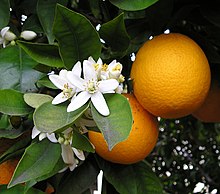Neroli
Neroli , also called neroli oil , is a distillate obtained from the flower of the bitter orange Citrus aurantium , more rarely from the orange Citrus sinensis - an essential oil .
Growing areas
Traditionally attributed to Sicily (according to legend, Neroli is said to have got its name from the Sicilian princess Nerola , who loved this fragrance very much), today it is mainly used in the countries of the Maghreb , i.e. Tunisia , Morocco and Algeria , but also in Spain and in the Caribbean cultivated.
Manufacturing
About one kilogram of essential neroli oil is obtained from a ton of flowers by steam distillation. Also, the extraction with organic solvents such as hexane is possible.
As Neroliwasser is Hydrolat referred, which, unlike the neroli oil hardly terpenes contains.
composition
| safety instructions | |||||||||
|---|---|---|---|---|---|---|---|---|---|
| Surname |
Neroli oil from Citrus Aurantium L. |
||||||||
| CAS number |
72968-50-4 |
||||||||
|
|||||||||
In natural materials , the composition will vary, but typically consists Neroli from about 35% terpenes ( camphene , pinene ), 30 to 35% terpenols (especially linalool , further terpineol , geraniol - nerol and D - nerolidol ), 10 to 11% esters and aldehydes and ketones .
use
- As an ingredient in perfumes . Neroli is delicately flowery, fresh, sweet, radiant and lovely in the fragrance profile. It is used for the heart note .
- Neroli is used for aromatherapy because of its relaxing and anticonvulsant, but at the same time stimulating effect and should not be confused with orange peel oil.
Web links
- Product specification neroli oil (PDF; 318 kB) from Sanabio
Individual evidence
- ↑ a b Data sheet neroli oil (PDF; 54 kB) from Sanabio , accessed on June 13, 2016.




